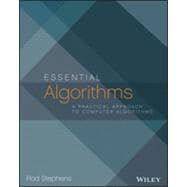A friendly and accessible introduction to the most useful algorithms
Computer algorithms are the basic recipes for programming. Professional programmers need to know how to use algorithms to solve difficult programming problems. Written in simple, intuitive English, this book describes how and when to use the most practical classic algorithms, and even how to create new algorithms to meet future needs. The book also includes a collection of questions that can help readers prepare for a programming job interview.
- Reveals methods for manipulating common data structures such as arrays, linked lists, trees, and networks
- Addresses advanced data structures such as heaps, 2-3 trees, B-trees
- Addresses general problem-solving techniques such as branch and bound, divide and conquer, recursion, backtracking, heuristics, and more
- Reviews sorting and searching, network algorithms, and numerical algorithms
- Includes general problem-solving techniques such as brute force and exhaustive search, divide and conquer, backtracking, recursion, branch and bound, and more
In addition, Essential Algorithms features a companion website that includes full instructor materials to support training or higher ed adoptions.








